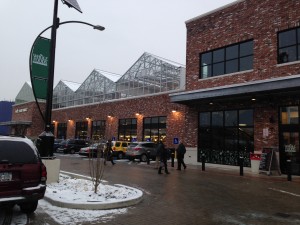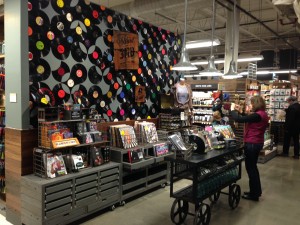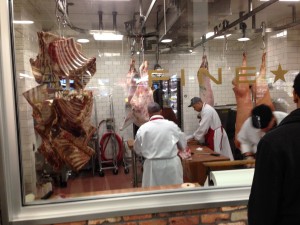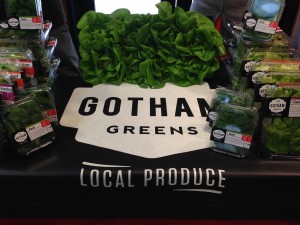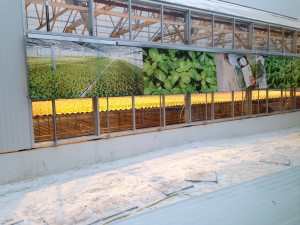On Tuesday, December 17th, the first Whole Foods Market store opened in Brooklyn.
Now, I’ve got to admit, I fought really hard to not write about this. I said to myself, “Self, not a single solitary person gives even a quarter-damn about WF opening in the borough. Have every seat in the auditorium.” But, since a few of you asked…
Suffer through it, you will. (…and it’s long.)
I’ve written a few times about my relationship with Brooklyn as a whole, because it is contentious. For years – wow, I really make it sound like it’s been way more than the 3 years it’s been – I resented that I’d left my quaint, quiet corner of Miami for all this… noise. And, when I wrote about it, so many of you that have either commented here or seen me on the streets encouraged me to actually dig deeper into Brooklyn – learn about it, learn about what makes it what it is, what makes the borough tick. Get involved in my community, meet the people – really meet them – and listen to what they’re saying.
I’m really glad I took your advice.
Brooklyn is complicated. It’s more than gentrification and stop-and-frisk – it’s culture, it’s respect, and it’s pride. It’s pride in the fact that your little corner of Brooklyn all migrated from the same island and came together and helped each other and loved on one another until you could be something that family back home could be proud of. It’s loving the culture that raised you when you migrated as a baby, and carrying your home flag in your left pocket, and the American flag in your right. It’s pride in your neighborhood (or your ‘hood, no judging) and the fact that you have everything you need within a three block radius. Hell, for some, it’s pride in “not being Manhattan.”
That’s part of the problem with gentrification: it feels like a bunch of people who can’t afford to live like Manhattanites in Manhattan decided they’re going to come in, push your ass out of your family’s neighborhood, and change the neighborhood into some low-rent version of the neighborhood they couldn’t originally afford in the first place. People who don’t give a damn about the block parties and family barbecues where everybody can come get a plate, J’ouvert, or the little old lady in 5C who can’t come up or down her stairs all of a sudden move in, decide you’re the problem, and start to treat you as such. When the pride that you feel for your culture and community isn’t respected, and your culture is practically treated like a unique type of problem; when you’re disrespected and treated as expendable, tensions flare.
This is all, totally, a separate blog post.
What’s more, Brooklyn somehow became the “home of the hipster.” The thick-rimmed glasses rocking, ironic flannel shirt and worn down jeans wearing, awkward hairstyle having hipster from “some flyover state” coming in with Mommy and Daddy paying their rent while they start their fancy lip chap factory in Williamsburg or Bushwick – ahem, excuse me, East Williamsburg – who is ruining the city and pushing long-time residents away from the parts of BK they need most access to: the ones near the train. Further and further down the L, further and further down the 3, you can see the gentrification. Opening a Whole Foods in Gowanus, of all places, felt like “the Manhattanization of Brooklyn;” turning it into this awkward and expensive, unreachable place with unaffordable prices and obscene rents, and we’d all be pushed to the margins… or to Jersey. And no one wants that. (Zing!)
If you look in the right places, you see interesting conversation about the Whole Foods opening. Just a few quotes:
“Whole Foods opened in Gowanus, Brooklyn today. Sorry, guys, but that means Brooklyn is over.”
“leave it to brooklynites to have raging hardons for an opening of a commercialized, publicly-traded supermarket on a bad snowy day.”
“Oh Generation X… 1. Flee the suburban blight and homogenization that you grew up in. 2. rent in the city to be part of something, and a community 3. Buy in brooklyn to have more space, and maybe a few kids. 4. Turn brooklyn into the suburbs.”
“You totally should fear another wave of gentrification that raises your rent (or property value) and the cost of living (and quality) in your neighborhood. It’s better to keep Brooklyn neighborhoods unattractive enough so that Manhattanites and suburbanites won’t want to move into the area with their cultural homogeneity, annoying children, and SUVs, So please, deprive as many neighborhoods in Brooklyn of fresh produce, meat, fish, dairy, and other healthy essential groceries and leave us to our local bodegas with our sugar and sodium packed processed and prepared foods/beverages and leave us to our food co-ops that attract less than .25% of Brooklynites.”
I’m pretty sure my original thoughts are all over the place, but I haven’t really seen them echoed anywhere else, so here they are:
1) In my mind, WF coming to Brooklyn for the first time only had two options – Gowanus and Red Hook. Whole Foods isn’t a small store, and New York City doesn’t traffic in massive box spaces. Whole Foods built that space from the ground up – reclaiming wood from Coney Island’s Hurricane Sandy leftovers, thousands of bricks from Jersey – and needed space to do it without demolishing a space that could’ve been used to build [affordable] housing. Saying Gowanus – and its canal – isn’t a good choice is silly. If anything, it’ll encourage more development of livable spaces in Gowanus and possibly entice the city to do something about the damn canal, since more people living there means more people turning their noses up at it and making noise about it.
Not only that, but because Gowanus is so industrial, there aren’t very many competitors in the area; chances aren’t particularly high that they’re going to be crushing too many local mom and pop stores. There might be a bagel shop on the other side of the dog park on the edge of Park Slope that could be in trouble, but even then – not really. NYers are walkers, but what I look like walking to WF when a good bagel shop is right here?
2) The store knows exactly who their target market is. A glass window separates hanging animal carcasses from the public, hungry for meat that is “natural,” devoid of pink slime or any of its little friends. The end of an aisle displays a decorated wall full of vinyl. Just… because. The standard “home-y, farm-y font” typography was everywhere. Giant, massive maps of Brooklyn covered the walls. People excited to be in Brooklyn would’ve loved this place. Many people who’ve spent their lives being of Brooklyn, however, might not’ve seen themselves represented in the store, and that’s sad, because…
3) While it’s funny to suggest that only They of Flannel Shirts and Ironic Haircuts would be the only people in that Whole Foods because “LOL, Poor Brooklyn, Brooklyn poor;” that only suggests to me that some people have never actually traveled past Franklin Avenue on the 4. Plenty of us get on that downtown train at Union Square or Chambers Street, get off at Kingston or Utica or Van Siclen and carry our groceries home. It is a long, arduous trek, but we make it anyway, because Whole Foods has something that many of our local stores can’t provide – a guarantee on quality produce.
I’ve been toying with the idea of blogging about income inequality and how it affects wellness for quite some time, now, and it all started with a random #ButYouGotThemJsThough conversation I was having with Eddy over bread and wine (because LOL Poor Brooklyn, Brooklyn poor), who actually bought his first pair of Jordans ever in life a few months ago. He said to me, “You know, I never fully understood why I lived in this neighborhood and couldn’t afford these shoes as a kid, but other kids who lived down the block showed up at school and it felt like they always had a fresh pair.” And, together, we realized that lots of people who live in poorer neighborhoods aren’t, in fact, actually poor.
Take a look at this article from USA Today:
The average affluent black and Hispanic household — defined in the study as earning more than $75,000 a year — lives in a poorer neighborhood than the average lower-income non-Hispanic white household that makes less than $40,000 a year.
“Separate translates to unequal even for the most successful black and Hispanic minorities,” says sociologist John Logan, director of US2010 Project at Brown University, which studies trends in American society.
“Blacks are segregated and even affluent blacks are pretty segregated,” says Logan, who analyzed 2005-09 data for the nation’s 384 metropolitan areas. “African Americans who really succeeded live in neighborhoods where people around them have not succeeded to the same extent.” [source]
The article makes this weird “separate but unequal” argument that, in my mind, removes agency from the choice. There are numerous reasons why a middle-class non-white household would choose to live in a non-wealthy neighborhood, and it’s even implied in the article: society teaches you that acquiring wealth is supposed to protect you from being near “the poor,” whomever they may be. Upwardly mobile blacks rarely receive that message and, oftentimes, reject it on its face: I was that poor person once, I know what it’s like, I know it’s not always so bad, I know the people aren’t just waiting to rob me at every turn, I know I don’t need to clutch my purse every time someone walks towards me*. The poor aren’t people to fear, not to the point of me paying triple the rent to avoid them. It’s not to an affluent black or Latin@ household’s disadvantage that they live among the poor – it’s to their advantage to have that insight, economically speaking. If anyone’s at a disadvantage, it’s affluent whites – being raised to fear the poor and the brown, to the point where they’re losing thousands of dollars per year (in some cases, per month) just to not be faced with them. (This is part of why gentrification is so infuriating – it feels like our little secret has been found out.)
Why does all of this matter? Because as I walked through that Whole Foods so early, mine most certainly wasn’t the only brown face in the building. I saw beautiful families with bouncing babies in the brand-spanking-new shopping carts; groups of girlfriends who’d apparently found that magical and elusive perfect brown-skinned foundation getting their coffee and croissants; several Old Black Grandmas™, flanked by their grandbabies carrying everything they wanted to buy; a few of the foinest – and I know you know what I mean by foine – black men in suits and ties, obviously calling in late to work to snoop around the store. I mean, the store’s consumer base represented Brooklyn. Clearly. The “hipster” shit is getting old now.

the wf gowanus delivery map
4) Let me get back to that “traveling on the train with your groceries” thing. Knowing that you have to carry your things from the store to the subway, down the steps to swipe your card, down the steps to the platform, either sit with them or stand with them corralled between your legs, carry them back up the stairs, out of the turnstile, up another flight of stairs, out of the subway, down the street to your house, and [possibly] up several flights of stairs… knowing that this is the road ahead greatly affects the way you shop. Suppose you work in the city, and stop by WF on your way home, like many people. You try to get the most for the mass you have to carry, as opposed to the price and value. That affects what you buy, and how often you shop. You might wind up spending “eighty bucks for six things” several times a week, simply because you’re not interested in carrying a bunch of crap after a long day. Now, Brooklyn gets delivery. You can buy everything you want and need, and have it delivered to your house out by Livonia. No carrying necessary. That’s a huge deal.
5) I was actually pretty irritated by how much cheaper stuff is at this store. I mean, my face frowned up at how much my purchase totaled up to, here – I doubt the rent is as high here as it might be in the LES or TriBeCa, for that matter, so of course the prices won’t be so sharply affected.
6) I spent some time talking to the employees of these stores, just because it’s a habit now that so many of you told me to stop being so frigid. People who live out in Flatlands, Crown Heights, Brownsville are working at and running this store. What is that doing for Brooklyn’s economy? How much money is this going to positively funnel into local hood Brooklyn shops? What’s more, the store has hired people with disabilities to handle tasks most suitable to their talents. I’m sorry, but I’m happy to see a store that can pay people, treat them well, and include people often pushed to the margins at the same time.
7) (Why am I typing so much?) The store has a farm on the roof. No, really. Gotham Greens has a massive farm that spans the majority of the roof. The other part of the roof, a bar with a menu and an outdoor seating deck with a view of… the Gowanus Canal, the gloriousness that she is. The canal is disgusting – ask anyone and they’ll tell you – but it makes this store’s choice to bank on the edge of it an interesting one. Who thinks WF (or its customers) could have the juice to get it cleaned?
Yes, stare at it with your early morning coffee, early morning croissant, and early morning appetite. And then call your congresspersons and demand that they clean it up. The car covers in the parking lot – parking lot! in New York City! – have rain catchers for the farm, and solar panels to power the store. The electric car charging ports are powered by wind turbines. The store represents exactly what its consumers want – companies that show effort in respecting the environment and its employees – and offers it at a price its consumers are willing to pay. I ain’t mad at that.
8) What will this do to other stores in the area? Will the Pathmarks, Associateds, and Key Foods in the area take a hit? Will the stores in the hood take a hit? Will they see what their old consumers are buying up at WF, and try to compete? Will other stores take this as a hint, and expand their produce section? Or step up their quality?
9) Everyone who keeps making ridiculous statements about how “Brooklyn is over now,” clearly knows little to nothing about BK. It’s gon’ take a lot more than a grocery store to ruin BK.
Now, I purposefully waited a few weeks after the newness of the store opening partly because I wanted to avoid the post-opening-related rush of people Googling for conversations about the store, but also because I wanted more people to be able to chime in on its opening. What do you think? What did I miss?
What do you think? Have you been?
Oh, and if you’re wondering about how I make Whole Foods affordable:
- Friday 5: Five Tips For Surviving Whole Foods, Wallet (And Paycheck) Intact
- How To #surviveon35, In Whole Foods, Buying Organic, And Keeping Your Wallet Intact
- The “Save Money On Groceries” Series on BGG2WL


